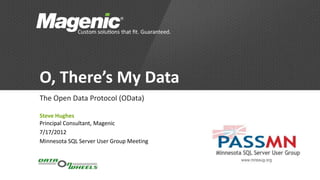
O Theres My Data The Open Data Protocol (O Data)
- 1. O, There’s My Data The Open Data Protocol (OData) Steve Hughes Principal Consultant, Magenic 7/17/2012 Minnesota SQL Server User Group Meeting
- 2. I called you all here … » Mark Souza » Why use OData? » Is it really necessary for Data Pros?
- 3. Introducing the Open Data Protocol » Commonly known as OData » Built on established protocols » REST » Atom » HTTP » Open specification from Microsoft » Designed to expose data from a variety of sources
- 4. OData Feeds » Data structure support » Tables » Foreign keys » Stored procedures » Data type support » Originally designed to support SQL 2008 and Entity Framework » Designed to be flexible » For example, Oracle EF implementation can be supported
- 5. Entity Data Model » This is the structure of the feed » Entity Type » Individual entity in the feed, similar to a row » Entity Key » One or more entity properties making each entity type unique in the feed » Entity Set » Collection of entities, essentially a table » Service Operation » Function or stored procedures that can be used in the feed
- 6. Building a Model Using Visual Studio to build a model
- 7. Windows Communication Foundation » “WCF is a unified programming model for building service-oriented applications.” – MSDN (http://msdn.microsoft.com/en- us/library/dd936243.aspx) » WCF supports multiple network protocols including HTTP and TCP » WCF supports multiple message formats such as SOAP and REST » We will use a WCF project to expose an OData feed based on our entity model
- 8. Building a WCF Service Using Visual Studio to create the WCF Data Service
- 9. Native OData Support » Consumers (read feeds) » PowerPivot & SSAS Tabular » Reporting Services » Distributors (expose feeds) » Windows Azure Table Storage » Windows Azure Marketplace » SharePoint » Stack Overflow
- 10. PowerPivot Demo Consuming our OData feed with PowerPivot for Excel
- 11. Painful OData Support a.k.a. SSIS » SSIS does not natively support OData feeds » My goal – use OData as an SSIS Source » Technology tried along the way » LINQ » Able to connect to the feed but not the right tool for SSIS » ATOM & XML » Works – creates files on the server, not the best option, but it works » DataServiceQuery » Works – allows us to create SSIS Source task which returns rows
- 12. OData Feed in SSIS Showing how to retrieve data from OData feeds in SSIS
- 13. References » Connecting to Windows Azure SQL Database Through WCF: http://msdn.microsoft.com/en-us/library/windowsazure/ee621789.aspx » Loading Data from an ATOM Data Feed into SQL Server: http://channel9.msdn.com/Learn/Courses/SQL2008R2TrainingKit/SQL10R2UPD01/S QL10R2UPD01_HOL_03/Exercise-1-Loading-Data-from-an-ATOM-Data-Feed-into- SQL-Server » SSIS – Using a Script Component as a Source http://www.ssistalk.com/2007/04/04/ssis-using-a-script-component-as-a-source/ » DataServiceContext Class: http://msdn.microsoft.com/en- us/library/system.data.services.client.dataservicecontext.aspx » Chris Woodruff – 31 Days of OData Blog Series: http://chriswoodruff.com/2011/11/19/announcing-the-31-days-of-odata-blog- series/
- 14. Wrap Up » Creating an OData feed requires .NET coding » Consuming an OData feed – Native vs Custom »Q&A
- 15. Steve Hughes » Principal Consultant with Magenic » Over 15 years with SQL Server » Chair of Minnesota SQL Server User Group (PASSMN) » PASS Regional Mentor for US-NorthEast Region » Contact Info » Blog: http://www.dataonwheels.com » Twitter: @DataOnWheels » Email: steveh@magenic.com
Editor's Notes
- New ProjectUse WCF Service Application TemplateNeed to Run As Admin to support IIS workRemove .cs file and App_Data, not needed for this solutionAdd New Item – Data – ADO.NET Entity Data ModelUse Wizard and Generate from DatabaseChoose data connection – AdventureWorks 2008 versionChoose your database objectsChoosing Department and EmployeeClick Finish to generate modelView model browser – note entity sets are pluralized entity types
- Add New Item – Web – WCF Data Service(remove other service)Open .svc.cs fileAdd DataService Name in class definitionAdd config.SetEntitySetAccessRule(“MyEntitySet”,EntitySetRights.AllRead); for each table to be exposed as an entity setDebug - .svc file to see Atom definition
- In PowerPivot windowChoose Connect to a Data FeedGive it a nameUse the URL from the feed - .svcChoose tables which are actually entity setsClick finishNOTE: for my demo to work I needed to change the connection string in the package to use an SQL user. Otherwise it will pass windows credentials, I am not on a domain so that is likely my issue.
- Walk through both packagesStart with UsingATOMCreate ATOM FileProcess ATOM FileLoad DataThen UsingRSSGet ODataSource Script Component walk through
